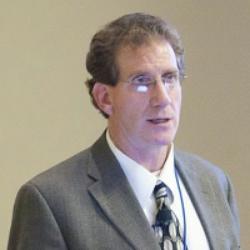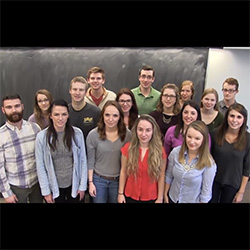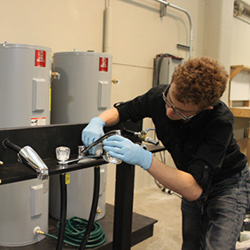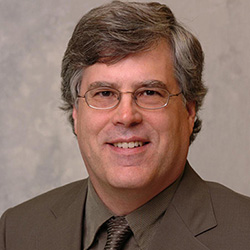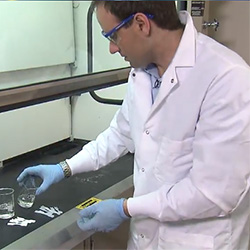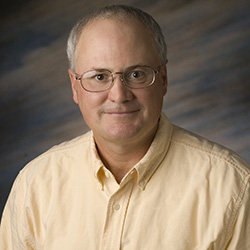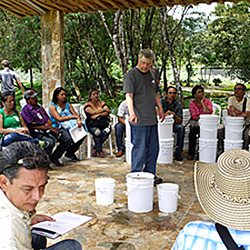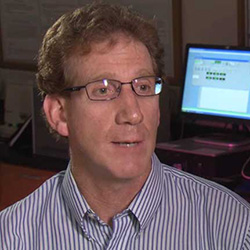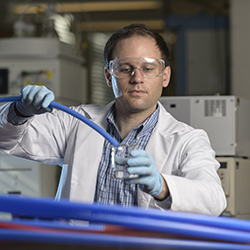Environmental Engineering
Environmental Engineering
With only one world to live in, environmental engineers are helping make sure we handle it with care. The skills of environmental engineers are
becoming increasingly important as we attempt to protect the fragile resources of our planet. Students in Environmental Engineering will have the
opportunity to apply science and engineering principles to improve the environment, water, air and land.
In Civil Engineering you can prepare for a great future with an environmental engineering career that offers a remarkable opportunity to positively affect the quality of life in our communities, our country, and our planet. Check out the Environmental Engineering area and join in on the excitement! You will have opportunities for research and education in a wide range of issues, including remediation of contaminated soils and sediments, industrial and solid waste treatment, water and wastewater treatment, air pollution measurement and control, urban and agricultural air and water quality management, understanding the environmental fate of pollutants, and sustainable engineering. Other options are also available through the
Division of Environmental and Ecological Engineering.
Our Environmental Engineering faculty have leadership roles and participate in numerous national and campus centers and institutes. We offer flexible academic options and research opportunities in our top
environmental facilities for undergraduate students, as well as MS and PhD graduate degree programs. The Purdue Air & Waste Management Association also offers opportunities for student involvement in the advancement of environmental knowledge.
Spotlights
April 19, 2016
Civil Engineering and Environmental and Ecological Engineering Prof. Chip Blatchley was featured in WalletHub’s recent study examining 2016's greenest states, lending his insight into eco-friendliness at the household, government and global levels.
March 24, 2016
Once a week for two hours, students in majors ranging from agricultural economics to nursing to engineering gather in Armstrong Hall and work toward a common goal: designing, building and implementing water treatment systems for small, impoverished communities in the Dominican Republic. These students are all a part of the course "Water Supply in Developing Countries."
March 24, 2016
Larry Nies, professor of civil engineering and environmental and ecological engineering, has been named the recipient of a 2016 Outstanding Undergraduate Teaching Award in Memory of Charles B. Murphy. Nies was surprised with the news on Wednesday (March 23).
November 4, 2015
Ph.D. student Hamed Zamenian is the recipient of a $2000 scholarship from the Indiana Chapter of the International Air and Waste Management Association for his active participation and outstanding leadership as a student member and former Vice President and Treasurer of the Purdue Student Chapter of the Air and Waste Management Association (PAWMA).
October 20, 2015
A new mathematical model allows researchers to better understand and plan the designs for infrastructure to account for human factors in systems ranging from small-scale agriculture to urban infrastructure.
September 10, 2015
A new study reveals a pressing need to better understand water use in America's rivers, with implications for drought-stricken regions of the country. Findings from the study showed that virtually all of the water entering the Wabash River in Indiana during summer months is withdrawn and then returned to the waterway.
August 28, 2015
Instructions given to the public by water companies and other authorities in the aftermath of chemical contaminations are inconsistent and not validated by science. So says Prof. Andrew Whelton and other scientists in the US who are developing models to understand complex plumbing systems to ensure consumers get the best guidance on how to regain access to safe drinking water.
August 10, 2015
A new study provides guidance to health officials and drinking water providers on how to decontaminate plumbing systems.
May 12, 2015
Professor Chad Jafvert recently completed a $600,000 research project funded by the U.S. EPA on the environmental fate of carbon-based nanomaterials. This is one of the first studies to report on the environmental fate of this emerging nanomaterial.
April 28, 2015
More than 1 million storm-water culverts that drain U.S. roadways are in need of repair. State Departments of Transportation (DOTs) have turned to cured-in-place pipe, or CIPP, as a fast and low-cost way to rehabilitate the aging systems. Professor Andrew Whelton and his team were recruited to take a closer look at CIPP's environmental effects.
April 15, 2015
In January 2014, thousands of gallons of chemicals spilled into West Virginia's Elk River, near Charleston. With support from a National Science Foundation (NSF) rapid response research grant (RAPID), environmental engineer Andrew Whelton led a research team that went door-to-door taking water samples within days of the spill.
April 7, 2015
Prof. Larry Nies has been named the recipient of the 2015 Excellence in Environmental Engineering Education (E4) Award, given annually by the American Academy of Environmental Engineers and Scientists.
March 26, 2015
Inez Hua, Professor of Civil Engineering and Environmental and Ecological Engineering, was recently appointed as a member of the Safe and Sustainable Water Resources, a subcommittee of the U.S. EPA Board of Scientific Counselors (BOSC), for a three year term.
February 17, 2015
CE senior Mariah Schroeder aspires to tackle a problem she finds very prevalent: the waste water draining into the local Wabash River.
January 29, 2015
Purdue civil engineering and environmental and ecological engineering professor Chad Jafvert will explain how Purdue undergraduate students are working to alleviate water troubles in global developing areas by designing point-of-use drinking water treatment systems during the next Science on Tap.
January 15, 2015
West Virginians suffered adverse health effects inside their homes after following plumbing-system flushing directions in response to a chemical spill last January, and these recommendations failed to consider the dangers of chemical vapor exposure, according to a new study.
January 8, 2015
Prof. Chip Blatchley received $31,186 from the Trask Innovation Fund to support "Continuous-Flow Solar UV Disinfection System," an innovation that kills waterborne microorganisms and produces safer drinking water.
December 18, 2014
A new report recommends that states require standardized testing to safeguard against environmental contamination caused by a widely used method for rehabilitating aging drainage culverts. Culverts divert stormwater away from roadways and are frequently made of concrete or corrugated metal. These objects are generally out of sight, but across the United States culvert infrastructure is decaying, said Andrew Whelton, an assistant professor in Purdue's Division of Environmental and Ecological Engineering and Lyles School of Civil Engineering.
October 20, 2014
Andrew Whelton, an assistant professor of civil engineering in Purdue's Lyles School of Civil Engineering and Division of Environmental and Ecological Engineering, is leading research into the effects plastic pipes have on drinking water in eco-friendly green buildings in the United States.
July 31, 2014
A group of Purdue University students and faculty members have completed work on a system that makes safe drinking water available to a community in the Dominican Republic sickened by poor water.

